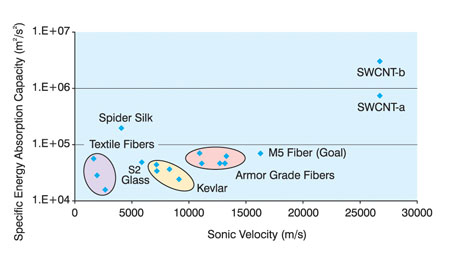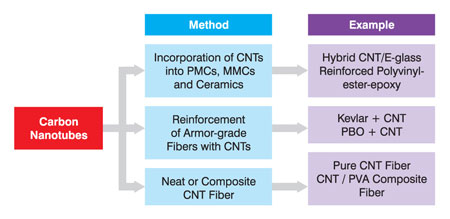| Posted: Aug 06, 2010 | |
Carbon nanotubes and the pursuit of the ultimate body armor |
|
| (Nanowerk Spotlight) With the ever-increasing multiple threats like traditional warfare, counterinsurgency and terrorism in border areas/urban centres/airports/public places etc. looming, there is an urgent need for providing reliable armor protection to personnel from the armed forces and law enforcement agencies. While today's new generation bulletproof vests can provide protection from most low- and medium-energy handgun threats, the current and future combat scenarios demand protection against more lethal ammunition, multiple bullet strikes, IEDs, small fragments from explosives such as hand grenades etc. In recognition of this, worldwide efforts are being directed towards development of improved lightweight body armor. For this purpose, high performance fibers are being increasingly exploited as soft, flexible fiber mats for the manufacture of body armor or bulletproof vests or as reinforcements in the form of polymer-matrix-composites (PMCs). | |
| High performance fibers and yarns commonly used in practice today for ballistic protection are S-glass, aramids (e.g., Kevlar 29, Kevlar 49, Kevlar 129, Kevlar KM2, Twaron), highly oriented ultra high molecular weight polyethylene (e.g., Dyneema, Spectra), PBO (e.g., Zylon) which is a p-phenylene-2-6-benzobisoxazole, new polymeric fibers such as Polypyridobisimidazole (PIPD) (referred to as M5) etc. These fibers are characterized by low density, high tensile and compressive strength, high modulus, high rupture strain, resistance to thermal degradation and high-energy absorption capacity. | |
| Currently, bullet-proof vests (soft or flexible composite armor used for body protection) are basically made from high stiffness and toughness, woven or laminated, polymeric fibers stacked in a number of layers. Upon impact of the striking bullet, the fabric material absorbs the energy by stretching of the fibers and the stiff fibers ensure that the load is dispersed over a large area throughout the material. This process slows down the bullet and ultimately stops it from penetrating the body. In case of polymer matrix composites (PMCs), the ability of a fiber to deform is severely restricted due to the presence of surrounding resin, and therefore, the energy absorption capacity is reduced. The main failure mechanisms in PMCs under ballistic impact are straining of fiber and its fracture, delamination and shear deformation in the resin matrix. | |
| To provide greater protection against blunt trauma and higher velocity ammunition than can be provided by a stand-alone soft ballistic vest, hard body armor has been developed. It includes a rigid facing comprising ceramic inserts, steel or titanium panels and a ballistic fabric backing. In hard armor with ceramic inserts, the kinetic energy of the projectile is absorbed and dissipated in localized shattering of this ceramic tile and blunting of the bullet material during its impact on the hard ceramic. | |
| Potential of carbon nanotubes for ballistic armor | |
| Carbon nanotube (CNT) is an ideal candidate material for bulletproof vests due to its unique combination of exceptionally high elastic modulus and high yield strain. A Young's modulus of about 1000 GPa, strength ranging between 13-53 GPa, and strain at tensile failure predicted to be as high as ∼16% typically characterize SWCNTs14. Assuming that the specific gravity of SWCNT is about 1.4 g/cm3, one can estimate the ballistic performance parameter to range between 2708 m/s and 4326 m/s. These values are in agreement with the previously reported value of 3000 m/s by Alan Windle for the ballistic performance parameter of carbon nanotubes. If one compares these values with those for other fibers suitable for ballistic applications, the enormous potential of CNTs as a candidate material for bullet-proof armor system is quite evident. | |
 |
|
| Specific energy absorption capacity as a function of sonic velocity for selected high performance fibers. | |
| There are three different approaches for utilizing carbon nanotubes to enhance the ballistic performance of a body armor. These are: | |
| 1) Incorporation of CNTs into PMCs, metals or ceramics to enhance their hardness or toughness and erosion resistance | |
| 2) Use of neat or composite fibers of CNTs in the form of woven or non-woven fabric, for achieving exceptional ballistic performance | |
| 3) Reinforcing the armor grade fibers like Kevlar, UHMWPE or PBO with CNTs to improve their elastic modulus and energy absorption capacity. These methods are schematically shown in the figure below. | |
 |
|
| Methods of employing carbon nanotubes for ballistic armor applications. | |
| Carbon nanotubes possess very high hardness. In fact, superhard materials synthesized by compressing SWCNTs at 24 GPa exhibit hardness of up to 152 GPa, which is even greater than that of a diamond sample. Therefore, incorporation of CNTs as one of the components in a polymer matrix composite armor tile is likely to deform/erode/ fracture the projectile when it is attacked, because of its extreme hardness. | |
| Carbon nanotubes, due to their unique combination of high elastic modulus and high strain to failure are capable of elastically storing an extreme amount of energy, which can cause the bullet to bounce off or be deflected. This attribute of carbon nanotubes can also provide the armor improved protection against blunt trauma effects. Based on their computational modeling studies, Mylvaganam and Zhang have shown that body armor comprising six layers of carbon nanotube yarns, each of 100 µm thickness, would have the capability of bouncing off a bullet with a muzzle energy of 320 J. | |
| The above-mentioned characteristic of carbon nanotubes has been practically utilized by Block Textiles, Inc., USA. The company has developed a light weight impact deflecting bullet-proof vest comprising directionally aligned single-walled carbon nanotubes in the matrix of an epoxy resin, that is near impervious to bullets fired at close range at all angles of incidence. Moreover, it also exhibits improved impact puncture and penetration resistance, which provides the wearer of the vest enhanced protection against blunt trauma effects. The above armor tiles can be fabricated by curing a mixture of carbon nanotubes in an epoxy resin under a controlled temperature and humidity environment and applying an electric field of sufficient strength to align the SWCNTs. The typical surface topography of the armor tile is shown in the following SEM micrograph, wherein the rope-like structure formed by the unidirectionally aligned single walled carbon nanotubes is quite evident. | |
| Researchers from Lockheed Martin Corp., have developed a hybrid composite containing fibrous reinforcement, wherein the polymer matrix is enhanced by the additions of either SWCNTs or MWCNTs (or combination of both). The incorporation of the CNTs in the PMC based armor results in improved ballistic properties and is reflected in significant reduction in the projectile velocity as determined by the V50 ballistic test. The above ballistic material developed is promising for applications in personal body armor, aircraft, ships, and armored vehicles. | |
| Nanocomp Technologies Inc., Concord, N.H., USA has been working with US Army's Natick Soldier Center to develop a new generation lightweight, body armor based on their CNT technology. Their proprietary CVD process is capable of producing large quantities of one-millimeter long CNTs, and CNT-based yarns, sheets and rolls. In April 2009, the company demonstrated that their ∼5 mm thick CNT-composite panels can stop a 9 mm bullet in controlled ballistic testing. Their body armor technology has now matured beyond early stage of development and has made considerable progress towards its commercialization. | |
| Currently, the hard body armor incorporates a ceramic tile strike face for providing superior ballistic performance while being lightweight. Alumina, silicon carbide and boron carbide are some of the candidate ceramic materials commonly used in body armor. Although these ceramics are very hard, they are also quite brittle and, therefore, hardly able to survive one or two shots before catastrophic fracture of the ceramic tile leading to collateral damage. Consequently, there is a need to improve their multi-hit capability. This could be achieved by enhancing their fracture toughness. | |
| Carbon nanotubes are being considered as a reinforcing material to enhance the mechanical properties of ceramics, particularly by fracture toughness, which is likely to improve their resistance against multiple hits by bullets. Recent studies have shown that incorporation of CNTs in ceramics like alumina and silicon carbide can have a strong influence on the microstructure, fracture mode and mechanical properties. A significant improvement of up to 94% in fracture toughness was observed when 4 vol. % of CNTs are added to alumina. | |
| Researchers from Military University of Technology, Poland have conducted numerical modeling investigations to determine the ballistic performance of CNT fiber reinforced 7017 aluminium alloy. Their numerical model analyzed the impact of a sharp nosed projectile on the metal matrix composite plate by performing computer simulations employing finite element methods and clearly showed that the CNT fiber reinforcement plays an important role in determining the overall ballistic resistance of the composite plate. | |
| By Y. R. Mahajan, CKMNT. These are excerpts from an article on CNT-enhanced armor and an exploration of its potential for ballistic applications. The full article – Pursuit of the Ultimate Body Armor – with an extensive list of references will appear in the July issue of Nanotech Insights. | |
|
Become a Spotlight guest author! Join our large and growing group of guest contributors. Have you just published a scientific paper or have other exciting developments to share with the nanotechnology community? Here is how to publish on nanowerk.com. |
|
